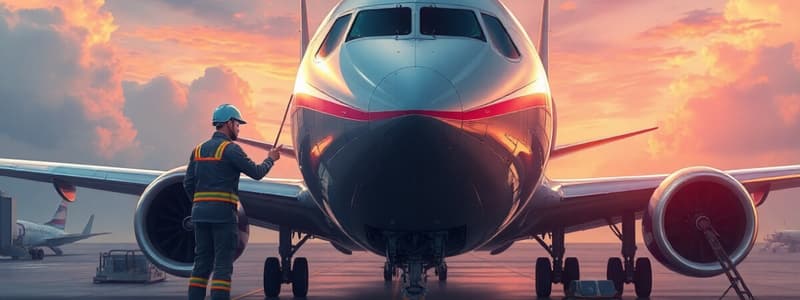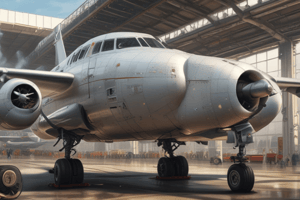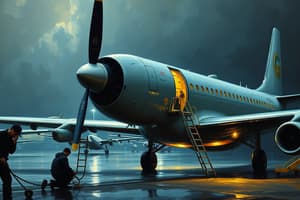Podcast
Questions and Answers
What are the two main categories of aircraft maintenance?
What are the two main categories of aircraft maintenance?
Routine maintenance and scheduled maintenance
What is a D Check?
What is a D Check?
- The most comprehensive maintenance check occurring every 6 to 12 years (correct)
- Minor inspections performed every few hundred flight hours
- Checks requiring significant downtime every 1–2 years
- Detailed inspections conducted every 6 to 8 months
B Checks are performed after 1 to 2 years.
B Checks are performed after 1 to 2 years.
False (B)
Which document contains detailed manufacturer-provided instructions for maintaining aircraft?
Which document contains detailed manufacturer-provided instructions for maintaining aircraft?
What is the purpose of the Illustrated Parts Catalogue (IPC)?
What is the purpose of the Illustrated Parts Catalogue (IPC)?
What does an Airworthiness Directive (AD) address?
What does an Airworthiness Directive (AD) address?
Service Bulletins are mandatory for compliance.
Service Bulletins are mandatory for compliance.
What are some examples of essential maintenance tools?
What are some examples of essential maintenance tools?
What records track the calibration status of tools used in maintenance?
What records track the calibration status of tools used in maintenance?
What practice improves teamwork in aircraft maintenance?
What practice improves teamwork in aircraft maintenance?
Proper ______ management involves distributing tasks evenly among technicians.
Proper ______ management involves distributing tasks evenly among technicians.
Flashcards are hidden until you start studying
Study Notes
Aircraft Maintenance Standard Practices
- Established guidelines for maintaining, inspecting, and repairing aircraft to ensure safety, reliability, and airworthiness.
- Include routine procedures like inspection, cleaning, lubrication, and testing.
- Governed by strict regulations and guidelines to maintain airworthiness and prevent mechanical failures.
Types of Aircraft Maintenance
-
Routine maintenance: Daily tasks ensuring safe operation (visual inspections, minor repairs).
-
Scheduled maintenance: Planned, comprehensive checks (A, B, C, D checks) following a detailed schedule for long-term airworthiness.
- A Check: Minor inspections (fluid checks, tire pressure, visual inspections); performed every few hundred flight hours or months.
- B Check: More detailed inspections, minor adjustments, component replacements; every 6-8 months (often combined with A checks).
- C Check: Extensive inspections of systems, structures, and components; every 1-2 years or after a set number of flight hours.
- D Check: Most comprehensive check (heavy maintenance); dismantling and thorough inspection; every 6-12 years.
-
Line maintenance: Frequent, quick inspections and minor repairs during service or short ground times (daily inspections, troubleshooting).
-
Base maintenance: In-depth checks requiring significant downtime (structural inspections, major system overhauls) at specialized facilities.
Aircraft Maintenance Documentation
- Standard Operating Procedures (SOPs): Standardized methods ensuring consistent maintenance and regulatory compliance.
- Aircraft Maintenance Manual (AMM): Manufacturer-provided instructions for maintaining, servicing, and inspecting aircraft. Specific to each aircraft type and requires updates.
- Illustrated Parts Catalogue (IPC): Reference for identifying and locating aircraft parts, providing detailed illustrations and part numbers.
- Component Maintenance Manual (CMM): Specific instructions for inspecting, repairing, overhauling, and testing individual components (engines, avionics).
- Service Bulletins (SBs): Manufacturer recommendations for upgrades, repairs, or modifications (not mandatory, but often address safety improvements).
- Airworthiness Directives (ADs): Legally enforceable notices from aviation authorities addressing known safety issues (mandatory compliance).
Maintenance Tools and Equipment
- Essential tools: Torque wrenches, multimeters, rivet guns, etc.
- Calibration: Accurate calibration is essential to prevent component damage or failure.
- Personal Protective Equipment (PPE): Gloves, safety goggles, hearing protection.
- Hand tools: Pliers, screwdrivers, wrenches.
- Power tools: Drills, grinders.
- Cleaning and degreasing equipment: Solvents, cleaning tools.
- Inspection tools: Borescopes, magnifying glasses.
- Ground Support Equipment (GSE): Tugs, jacks, lifts.
Maintenance Documentation and Records
- Logbooks and task cards: Record every maintenance task for traceability and regulatory compliance.
- Maintenance control records: Track the status of maintenance tasks, upcoming checks, and inspections for scheduling and compliance.
- Repair and overhaul records: Detailed documentation of repairs, overhauls, and major maintenance actions.
- Technical logbook (Tech Log): Records key operational information (fuel consumption, flight times, defects) from flight crews.
- Parts and material records: Track parts used, ensuring they meet standards (source, certification, traceability).
- Work orders: Detailed lists of tasks for scheduled maintenance (inspection, repair, replacement); includes sign-offs.
- Non-routine maintenance records: Document unplanned maintenance due to faults or malfunctions.
- Calibration records: Track calibration status of tools and equipment.
- Weight and balance records: Document changes to aircraft weight and balance following repairs or modifications.
- Modification records: Detail alterations or upgrades made to the aircraft.
- Serviceability tags: Indicate whether components are serviceable ("green tags") or unserviceable ("red tags").
Human Factors in Maintenance
- Fatigue management and communication: Proper rest and clear communication among technicians are crucial to avoid errors.
- Maintenance resource management (MRM): Strategies to reduce human error through teamwork, training, communication, and safety protocols.
- Situational awareness: Being fully aware of the environment, tasks, and potential hazards.
- Stress management: Managing stress through time management, staffing, and a supportive work environment.
- Skill and knowledge proficiency: Continuous training and upskilling to stay current with technologies and regulations.
- Workplace ergonomics: Ensuring proper ergonomic support and tools to prevent injuries.
- Distraction and task interruption management: Minimizing interruptions to maintain task continuity.
- Complacency prevention: Encouraging vigilance and adherence to SOPs.
- Physical and mental fitness: Maintaining technician's physical and mental well-being.
- Teamwork and collaboration: Effective teamwork for efficient and safe task completion.
- Adherence to procedures: Strict adherence to SOPs and technical documentation.
- Workload management: Even distribution of tasks among technicians to avoid overwhelming workloads.
- Shift management and handover practices: Clear communication during shift changes.
- Error reporting and accountability: Open error reporting culture to foster learning and continuous improvement.
Studying That Suits You
Use AI to generate personalized quizzes and flashcards to suit your learning preferences.




